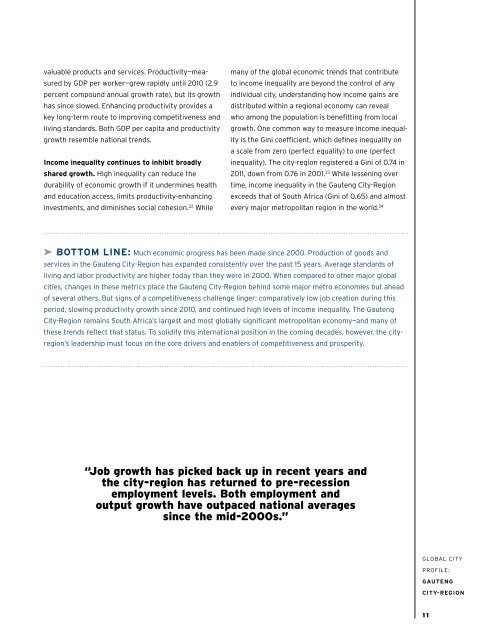SOUTH AFRICA’S
1HAwfit
1HAwfit
Create successful ePaper yourself
Turn your PDF publications into a flip-book with our unique Google optimized e-Paper software.
valuable products and services. Productivity—measured<br />
by GDP per worker—grew rapidly until 2010 (2.9<br />
percent compound annual growth rate), but its growth<br />
has since slowed. Enhancing productivity provides a<br />
key long-term route to improving competitiveness and<br />
living standards. Both GDP per capita and productivity<br />
growth resemble national trends.<br />
Income inequality continues to inhibit broadly<br />
shared growth. High inequality can reduce the<br />
durability of economic growth if it undermines health<br />
and education access, limits productivity-enhancing<br />
investments, and diminishes social cohesion. 22 While<br />
many of the global economic trends that contribute<br />
to income inequality are beyond the control of any<br />
individual city, understanding how income gains are<br />
distributed within a regional economy can reveal<br />
who among the population is benefitting from local<br />
growth. One common way to measure income inequality<br />
is the Gini coefficient, which defines inequality on<br />
a scale from zero (perfect equality) to one (perfect<br />
inequality). The city-region registered a Gini of 0.74 in<br />
2011, down from 0.76 in 2001. 23 While lessening over<br />
time, income inequality in the Gauteng City-Region<br />
exceeds that of South Africa (Gini of 0.65) and almost<br />
every major metropolitan region in the world. 24<br />
➤ BOTTOM LINE: Much economic progress has been made since 2000. Production of goods and<br />
services in the Gauteng City-Region has expanded consistently over the past 15 years. Average standards of<br />
living and labor productivity are higher today than they were in 2000. When compared to other major global<br />
cities, changes in these metrics place the Gauteng City-Region behind some major metro economies but ahead<br />
of several others. But signs of a competitiveness challenge linger: comparatively low job creation during this<br />
period, slowing productivity growth since 2010, and continued high levels of income inequality. The Gauteng<br />
City-Region remains South Africa’s largest and most globally significant metropolitan economy—and many of<br />
these trends reflect that status. To solidify this international position in the coming decades, however, the cityregion’s<br />
leadership must focus on the core drivers and enablers of competitiveness and prosperity.<br />
“Job growth has picked back up in recent years and<br />
the city-region has returned to pre-recession<br />
employment levels. Both employment and<br />
output growth have outpaced national averages<br />
since the mid-2000s.”<br />
GLOBAL CITY<br />
PROFILE:<br />
GAUTENG<br />
CITY-REGION<br />
11


